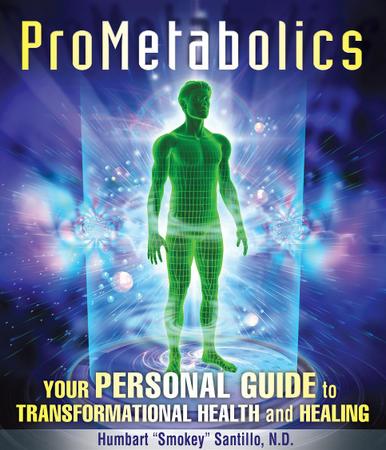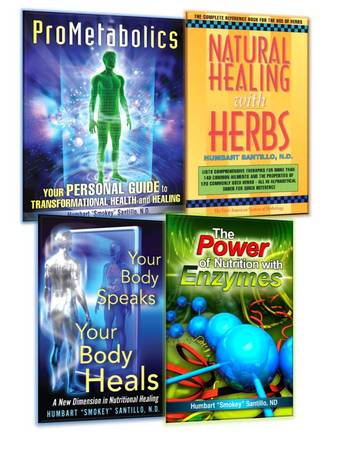Last week Dr. Santillo's eBook version of Your Body Speaks--Your Body Heals reached #4 on Amazon's Best-Seller list in the Alternative Medicine category!
For more info on Dr. Santillo eBooks CLICK HERE.
~~~~~~~~~~~~~~~~~~~~~~~~~~~~~~~~~~~~~~~~~~~~~~~~~~~~~~~~~~~~ 
The following excerpt is from Dr. Santillo's book
DISEASE-FIGHTING PHYTOCHEMICALS
Whole foods supply a cornucopia of beneficial compounds in a synergistic balance that can never be duplicated by man. Raw foods that are not processed or cooked have a God-given balance that co-exists as interconnected food elements: vitamins, minerals, enzymes, proteins, carbohydrates, and fats. Along with these traditional nutrients is another huge group of naturally occurring chemicals that are now known to benefit the body as well--you'll recognize their name as the current nutritional buzz-word "phytochemicals." The term is derived from the prefix "phyto," which means plant. Phytochemicals, also called phytonutrients, are compounds found naturally in fruits, vegetables, seeds, nuts, and legumes. There are literally hundreds and maybe even thousands of phytochemicals in each species of plant. Phytochemicals naturally protect their plant against viruses, bacteria, and fungus. There has been a lot of interest in these compounds because many of them act as free radical scavengers in and around our cells; slow the aging process; support and strengthen the immune system; and even reduce the risk of cancer, heart disease, and inflammatory conditions. Researchers have identified various specific phytochemicals as anti-aging and anti-cancer agents because they have been shown to modify gene expression. As you have read in previous chapters, our genes don't change, but their activity and effects can be modified by the foods we eat. Foods can be seen as having many levels of expression themselves. Not only do they contain all the familiar vitamins and minerals, but as we look deeper into the healing properties of herbs, fruits, and vegetables, we find hundreds of phytochemicals energetically combined and working with these known nutrients. We have also realized that cooking and processing our foods destroys many of these beneficial substances. Although some phytochemicals do remain in cooked foods, the only way to get them in their entirety and in their most useful forms is to eat raw or slightly steamed vegetables and fruits, or to drink fresh vegetable and fresh fruit juices. And because we know that many different phytochemicals in fruits and vegetables have only recently been identified, we must deduce that there could still be as many or more unknown substances yet to be discovered in these foods. An important consideration is how all of the nutritive substances work together to protect plants from dangers in their environment. It's logical to conclude that if you removed 100 of a plant's naturally protective chemicals, it would probably die or at least be altered in some significant way, just as we've all seen plants die or have leaves turn brown in deficient soil. The optimal function of any one of these chemicals depends on the presence of the rest of the chemicals normally found along with it--if you remove even one substance from the mix, you don't get the same expression or functional result. Isolated Nutrients versus Whole Foods We know we need our vitamins and minerals, but we know at times they just don't seem to work. As with phytochemicals, once you remove vitamins or minerals from their source, from their context of nutritional companions, you may get a completely different activity. An analogy: if you're listening to a symphony performed by eighty musicians and you remove one violin, not only is there something missing in the symphony, but the singled-out violin has lost its synergistic companions and, consequently, some of its own identity. It may be able to function at some level alone, but its solo performance will never be what it can achieve within the whole orchestra. The same idea applies to taking individual nutrients and thinking they'll act in the same way that they would if you'd eaten them in a whole food. We need both-individual supplements (for specific nutrient needs) and whole foods (for foundational nutrition)--but they are not alike. As mentioned, many unknown components contribute to the constitution of our foods and affect the performance of the nutrients that we do know about. We need to eat whole foods because no scientist could possibly produce a pill in which thousands of substances work together as they do in a plant produced by nature, and a supplement manufacturer obviously can't produce phytochemicals that haven't been discovered yet. The only way to get them is in whole foods and whole food-based supplements (see www.JuicePlus.com). A Primer on Phytochemicals Let me introduce you to several significant groups of phytochemicals and some particularly powerful foods: Phenols. Phenols protect plants from oxidative stress and perform the same function in humans. Phenols also help block specific enzymes that cause inflammation. Flavonoids. This is a group of more than 1,500 phenols that enhance the effects of vitamin C. Hesperidin and quercetin are examples. Flavonoids are mainly anti-inflammatory, but also act as free radical scavengers and protect against platelet aggregation, allergic reactions, and liver toxins. Among other benefits, taking vitamin C with flavonoids helps strengthen tiny capillaries. Quercetin. This specific flavonoid appears to protect against heart disease by inhibiting platelet aggregation, thereby reducing the risk of blood clots. Quercetin is also used to reduce inflammation in sports injuries and to reduce the problematic release of histamine from mast cells during asthma, bronchitis, and allergic reactions. Glucosinolates. Found in cruciferous vegetables, glucosinolates activate liver detoxification and help block enzymes that promote cancer growth. Glucosinolates also help regulate the activity of cytokines, which are hormone-like substances that help coordinate immune system responses and control inflammation. Phytosterols. These lipid (fat) compounds are similar to cholesterol. Some phytosterols are found in vegetables but are most concentrated in seeds. Phytosterols from seeds block the development of breast, colon, and prostate diseases, reduce inflammation, and help eliminate excess cholesterol from the body. Carotenoids. Carotenoids are a group of approximately 450 pigments found in yellow, orange, red, and green fruits and vegetables, berries of all types, grapes, and black currants. They stimulate the immune system and reduce the risk of heart disease and cancer. You've probably heard of the carotenoid beta-carotene. Lycopene. Lycopene is the reddish pigment in tomatoes. In the body, it is deposited in certain tissues such as the prostate gland (an example of selective nutrition). Lycopene helps prevent prostate cancer and heart disease. Lutein. Lutein is an antioxidant in the carotenoid family. It is found in green leafy vegetables such as spinach, kale, leeks, and romaine lettuce. Lutein protects against age-related macular degeneration, a leading cause of blindness in people older than sixty-five. Zeaxanthin. This phytochemical is also found in large amounts in spinach. Both zeaxanthin and lutein (above) have been found to protect the eyes against degenerative conditions. Ellagic acid. Ellagic acid acts as a natural pesticide in strawberries and raspberries. It also helps fight against cancers in humans. Indoles. Indoles are potent cancer-fighters found in broccoli, cabbage, kale, and Brussels sprouts. Sulforaphane. This compound has been shown to help prevent colon cancer. Sulforaphane is found in cruciferous vegetables such as broccoli, cauliflower, kale, Brussels sprouts, cabbage, collard greens, and turnips. Anthocyanidins. These water-soluble flavonoids (above) strengthen the collagen protein in soft tissues, tendons, ligaments, and bones, and are therefore particularly useful for athletes. Anthocyanidins also neutralize free radicals that damage soft tissue. More than 125 anthocyanidins of interest have been found so far. Catechins. Catechins are a group of well-known antioxidant flavonoids found in green tea. Citrus fruits. Citrus fruits contain numerous phytochemicals with a wide range of activities including anti-tumor and antioxidant properties and activation of the detoxifying P-450 enzyme system. An orange contains more than 170 known phytochemicals. Grapefruit and oranges contain nomilin and limonin, which activate the enzyme GST to help neutralize toxic substances in the body. Citrus pulp is rich in glucarate, which helps prevent breast cancer. Flaxseed. Flaxseed has been shown to lower cholesterol and is a good source of omega-3 fats. Flaxseed contains plant lignans, which appear to be anti-carcinogenic. In the colon, lignans are converted into phyto-estrogens, which are similar in structure to estrogen and can inhibit the growth of estrogen-stimulated breast cancers. Red wine and grape juice. These contain phenols and red anthocyanins, which are antioxidants that protect against lipid oxidation, thereby protecting against heart disease. Garlic and onions. Garlic and onions are rich in allyl sulfides, which tend to reduce cancer risk, lower total cholesterol, and help reduce blood clotting. (Detailed references are provided in ProMetabolics.)  |